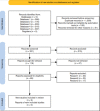The Stiff Joint: Comparative Evaluation of Monotherapy and Combination Therapy With Urate Lowering Agents in Managing Acute Gout
- PMID: 37842401
- PMCID: PMC10568651
- DOI: 10.7759/cureus.45087
The Stiff Joint: Comparative Evaluation of Monotherapy and Combination Therapy With Urate Lowering Agents in Managing Acute Gout
Abstract
Gout, an extremely painful form of arthritis, is triggered by the innate immune system's response to the accumulation of monosodium urate crystals in specific joints and surrounding tissues. This condition is characterized by recurring episodes of excruciating arthritis flares, interspersed with periods of disease quiescence. Over time, gout can result in disability, tophi formation, and severe pain. The treatment of gout is centered around two main objectives: alleviating inflammation and pain during acute gout attacks and long-term management to reduce serum urate levels and mitigate the risk of future attacks. Addressing inflammation and pain during acute attacks is often complicated by various factors, including underlying health conditions commonly associated with gout, such as hypertension, chronic kidney disease, cardiovascular disease, and diabetes mellitus. Moreover, gout patients are frequently older and have multiple coexisting health issues, necessitating complex medication regimens. Given the rising prevalence of gout and its associated comorbidities, there's a growing demand for improved treatment options. While existing treatments effectively manage gout in some patients, a significant portion, particularly those with comorbidities, face contraindications to these treatments and require alternative approaches. Innovative medications are required to enhance gout treatment, especially for individuals with concurrent health conditions. These considerations underscore the importance of reviewing both monotherapy and combination therapy approaches for acute gout treatment.
Keywords: acute gout; allopurinal monotherapy; lesinurad and allopurinal combination therapy; uricosuric; xanthine oxidase inhibitor.
Copyright © 2023, Okobi et al.
Conflict of interest statement
The authors have declared that no competing interests exist.
Figures
Similar articles
-
Treatment approaches and adherence to urate-lowering therapy for patients with gout.Patient Prefer Adherence. 2017 Apr 19;11:795-800. doi: 10.2147/PPA.S97927. eCollection 2017. Patient Prefer Adherence. 2017. PMID: 28458524 Free PMC article. Review.
-
Treating to target: a strategy to cure gout.Rheumatology (Oxford). 2009 May;48 Suppl 2:ii9-ii14. doi: 10.1093/rheumatology/kep087. Rheumatology (Oxford). 2009. PMID: 19447780 Review.
-
Patient considerations in the management of gout and role of combination treatment with lesinurad.Patient Relat Outcome Meas. 2018 Jul 18;9:231-238. doi: 10.2147/PROM.S108868. eCollection 2018. Patient Relat Outcome Meas. 2018. PMID: 30140163 Free PMC article. Review.
-
Gout: joints and beyond, epidemiology, clinical features, treatment and co-morbidities.Maturitas. 2014 Aug;78(4):245-51. doi: 10.1016/j.maturitas.2014.05.001. Epub 2014 May 14. Maturitas. 2014. PMID: 24880206 Review.
-
Lesinurad for the treatment of hyperuricaemia in people with gout.Expert Opin Pharmacother. 2017 Dec;18(17):1875-1881. doi: 10.1080/14656566.2017.1401609. Epub 2017 Nov 13. Expert Opin Pharmacother. 2017. PMID: 29103339 Clinical Trial.
References
-
- Overview of serum uric acid treatment targets in gout: why less than 6 mg/dL?. Ruoff G, Edwards NL. Postgrad Med. 2016;128:706–715. - PubMed
-
- High versus low dosing of oral colchicine for early acute gout flare: Twenty-four-hour outcome of the first multicenter, randomized, double-blind, placebo-controlled, parallel-group, dose-comparison colchicine study. Terkeltaub RA, Furst DE, Bennett K, Kook KA, Crockett RS, Davis MW. Arthritis Rheum. 2010;62:1060–1068. - PubMed
-
- Female gout: clinical spectrum and uric acid metabolism. . Puig JG, Michán AD, Jiménez ML, et al. Archives of internal medicine. 1991; 151(4):726–732. - PubMed
-
- Prevalence of gout and hyperuricemia in the US general population: the National Health and Nutrition Examination Survey 2007-2008. Zhu Y, Pandya BJ, Choi HK. Arthritis Rheum. 2011;63:3136–3141. - PubMed
Publication types
LinkOut - more resources
Full Text Sources

